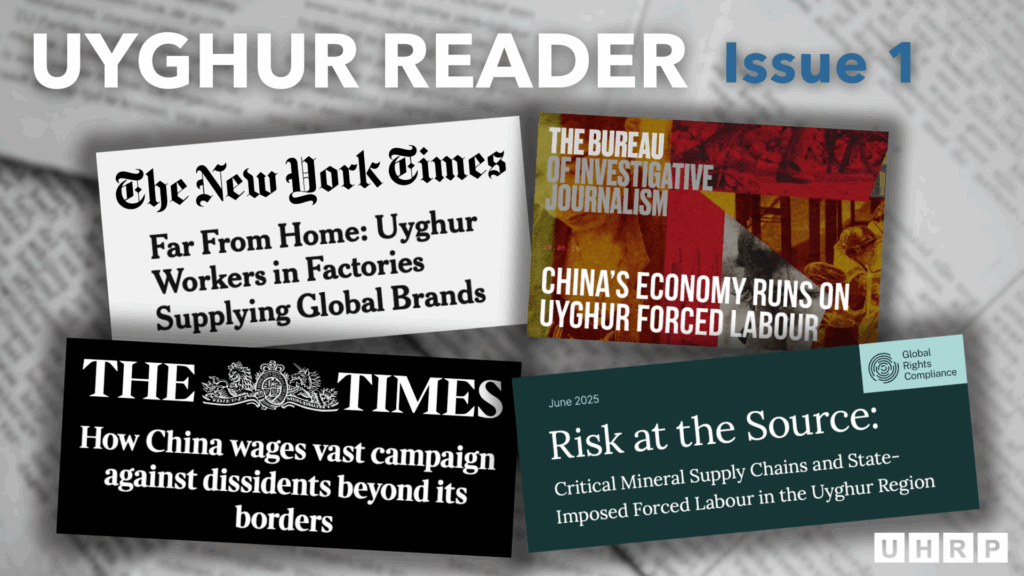The Uyghur Reader: Stories We’re Following (Issue 1)

Issue 1: May 28 to June 11, 2025
Welcome to the first issue of The Uyghur Reader, a biweekly content roundup curated by the staff of the Uyghur Human Rights Project.
Each issue features carefully selected articles, reports, and publications from media outlets, academic institutions, NGOs, and government sources. While we highlight urgent human rights issues, we also aim to reflect the breadth of the Uyghur experience, including politics, economics, history, and culture. Our goal is to provide a trusted resource for understanding the complexities and realities facing Uyghurs today.
This week’s selections from Director of Research Henryk Szadziewski and Associate Director for Research and Advocacy Peter Irwin.
On June 11, Global Rights Compliance released a report by Caroline Dale, Yalkun Uluyol, and Uyghur researchers who wished to remain anonymous, identifying dozens of global companies linked to forced labor in the Uyghur Region through their use of critical minerals. The report, “Risk at the Source: Critical Mineral Supply Chains and State Imposed Forced Labour in the Uyghur Region,” identifies major brands—including Avon, Walmart, Nescafe, Coca-Cola, and Sherwin-Williams—that may be sourcing titanium, lithium, beryllium, and magnesium from Chinese suppliers operating in the Uyghur Region. The minerals are found in globally traded products such as aerospace components, paint, and consumer goods. The Associated Press highlighted the report’s call for companies to urgently audit their supply chains under laws like the U.S. Uyghur Forced Labor Prevention Act.
In two articles published on May 29, The New York Times investigates China’s coercive labor practices in East Turkistan. “Far From Home: Uyghur Workers in Factories Supplying Global Brands,” by David Pierson, Vivian Wang and Daniel Murphy, examines how China has tried to circumvent U.S. import bans by relocating more Uyghurs to factory jobs in other parts of the country. In “How China Uses Work to Reshape Uyghur Identity and Control a Strategic Region,” David Pierson reveals how state-run labor programs, while promoted as efforts to alleviate poverty, have functioned as a means to suppress dissent and tighten control over the Uyghur Region. Also part of the series is a video, “How Uyghurs Are Coerced to Work in Chinese Factories,” by David Pierson, Rebecca Suner and James Surdam.
The above New York Times articles are part of a joint project with The Bureau of Investigative Journalism (TBIJ) and Der Spiegel. Daniel Murphy authored a sequence of in-depth reports for TBIJ, published between May 29 and May 31, 2025, uncovering the systemic nature of state-imposed labor transfers outside the Uyghur Region and their integration into global supply chains. Find the series here: “China’s Economy Runs on Uyghur Forced Labour,” “The World Sanctioned Xinjiang Cotton. China Turned It Into Chicken Feed,” “Did Coerced Labour Build Your Car?” and “Tracking Forced Labour Across China,” an interactive map with videos uploaded by workers to Douyin to trace the movement of Uyghur and other ethnic minorities from East Turkistan to factories across China.
In “How China wages vast campaign against dissidents beyond its borders,” published in The Times (UK) on June 1, John Beck details transnational repression targeting Uyghurs and other Turkic exiles, revealing a global system of intimidation that continues to haunt survivors long after they flee. UHRP’s Zubayra Shamseden provided translations that were included in John Beck’s new book, “Those Who Should Be Seized Should Be Seized: China’s Relentless Persecution of Uyghurs and Other Ethnic Minorities.” On May 27, UHRP’s Executive Director, Omer Kanat moderated the U.S. launch of the book. Read Ellen Bork’s June 10 review in The Wall Street Journal.
UHRP’s Director of Global Advocacy Louisa Greve highlights an op-ed by Omer Kanat published in The Diplomat on June 11. “The Battle to Save the Uyghur Language From Extinction: China’s Plan to Erase a Civilization” explains why Uyghur Language Day, June 15, is not just a celebration, but a powerful act of resistance against China’s efforts to erase Uyghur culture through the suppression of its language. Every child who speaks Uyghur, every poem and song created, becomes part of a larger struggle—and in saying “Happy Uyghur Language Day” (Uyghur tili kununglargha mubarek bolsun), Uyghurs reject the genocidal attempt to silence them.
Keep Reading:
- Nuria Khasim, The Guardian, June 2: Örkesh Dölet descended on to Tiananmen Square with thousands of fellow student protesters. He’s now 36 years into exile
- Sarah Ellison and Cate Cadell, The Washington Post, June 6: Chinese propaganda surges as the U.S. defunds Radio Free Asia
- Abdurehim Gheni Uyghur, Bitter Winter, June 6: Memtili Tewpiq: The Uyghur Teacher Who Was Burned to Death
- James T. Areddy, The Wall Street Journal, June 8: Harvard’s China Ties Become New Front in Battle With Trump
